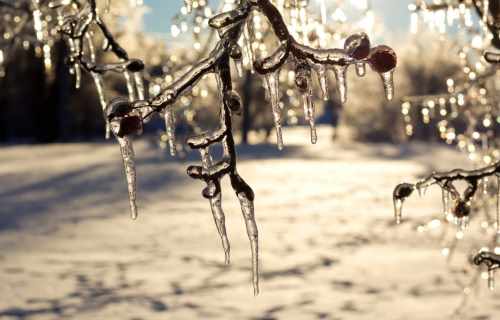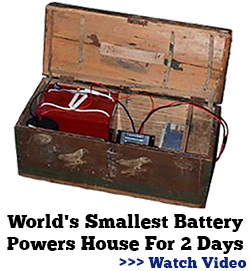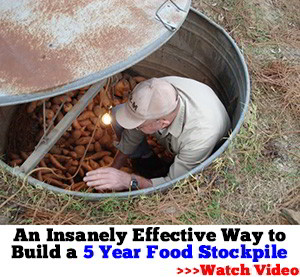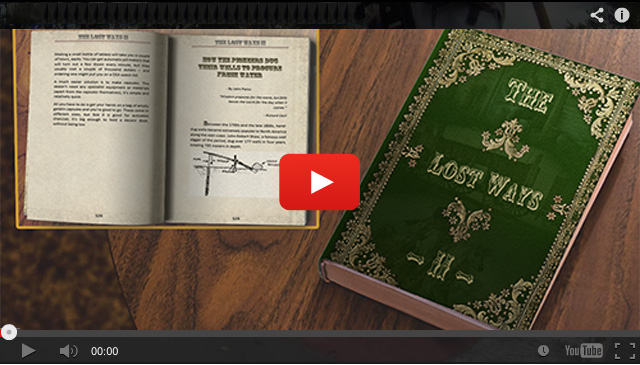As America is dealing with a record-breaking cold snap and a weird storm hitting the East Coast, some folks are having to handle the whole thing with the power out also. But we all know that at least this time, our situation is temporary. Most of us have power, and those who don’t will have it restored within a few days. But what if you had to stay warm during a long-term SHTF situation?
After your warm response to Selco’s story about Christmas during the SHTF in Bosnia, I hired him to start writing for us more often. Today, he shares with us what it was like to try and stay warm during an entire year in a war zone without any type of utilities. It’s a lot of information, and we can apply this to our preps.
Selco’s information is incredibly valuable because he has actually been through what we plan for during our preparedness endeavors. He teaches this information in-depth on his website, SHTF School. Let’s get started.
This article was originally published by Daisy Luther at The Organic Prepper
The US is dealing with quite a cold snap right now, and it got me thinking about your SHTF year in Bosnia. First of all, what is the winter like there? How cold does it get and what is the climate?
In a small part of the country close to Adriatic sea it is Mediterranean climate with mild winters and temperatures then goes just below 0 or -5 Celsius (32-23 Fahrenheit) and in other parts of country it is a Continental climate with temperatures during the winter -10 or -18 (14-5 Fahrenheit), with cold waves down to -26 (-15 Fahrenheit) and a lot of snow.
Very usual are periods of strong cold wind (Bora) that actually can lower your body temperature very fast and complicate things.
Sounds weird but after experiencing snow and -20 during SHTF and Bora at -2, I had most problems with that wind and -2 Celsius simply because it lowers your body temperature fast and suddenly.
Did you have any public utilities at all during this time?
All public utilities went off in first few weeks one by one. Electricity, water, heating (city central heating service) and phone lines, etc.
Did most people have homes with fireplaces or off-grid heating methods before this time period? Or were the homes modernized to the point that they were not functional?
During the late 70s and early 80s in the region, there was huge effort in modernizing cities heating services (partly because pollution) so majority of city apartment buildings and part of private houses were “connected“ on a public central heating system, either on natural gas or oil fuel (hot water system in radiators, through piping system)
As a result of that, building apartments had no fireplaces, even if they had places for smoke exhaust (vertical flue that provides a path through which smoke from a fire is carried away through the wall or roof of a building- exhaust) they were not in operating condition because nobody needed it for 20 years or so. They were clogged, destroyed, blocked, or similar.
Because that lot of home fires happened in first period of SHTF in apartment buildings simply because people wanted to install some kind of wood fire stove and send the fumes through an exhaust system that was not in use for decades.
I live in an apartment building now, in a building block of some 800 apartments. Again, the buildings have fireplace exhaust systems, but nobody used it for last 20 years, because the central heating is working perfectly.
So they are clogged, blocked, or destroyed.
Mine is in perfect operating condition and ready all the time because I keep it like that.
In private houses, the situation was bit different. Yes, people rely a lot on heating through eletric heaters but most of the houses still had fire wood stoves of some kind and operating exhaust system partly because tradition but also for heating.
Still, a lot of the homes that even had a fireplace (way and place to start a fire either for heating or cooking or both) they had it in, let’s say, not an economic way. Nobody thought that firewood was gonna be so expensive and hard to get. A lot of people simply had fireplaces as a decoration, not in a way to heat house in most economic way (in terms of used-fuel-heat-given ratio)
How did people stay warm?
We can say that first step was that people simply “shrunk“ their living space.
For example, if a family of people had a house with six rooms they simply stopped using four rooms, and they lived in two rooms only, because of a simple reason – it was easier to heat two rooms only.
To get wood for heating was a hard process and often dangerous, so how much fuel you spent in your home was a matter of staying alive.

Old style wood stove with a smoke-exhaust-pipe (that would be put through the hole in the wall to outside- if a chimney-exhaust system was not existing in that room.
Comfort was completely forgotten because of necessity.
Also people insulate their homes with what they had. A majority of windows were crushed (glass) because of detonations (shelling), so people blocked window openings with what they had.
Blanket, pillows, nylons, and tarps were used for that. Also, duct tape was a very useful item.
Homes were kinda rearranged in order to make it more energy efficient in very rudimenrtary ways. For example, if a house had smoke exhaust just in the kitchen but that kitchen was not good for having wood stove there, then simply stove was moved from that kitchen into the desired room. A hole was made in that room (for smoke exhaust) and the stove was put there.
You need to understand that homes (houses, apatments) when SHTF were very fast to deteriorate. There was no service to call, remember. Leaks from the roofs, freezing temperatures… all that makes your house quite problematic to live in. We were trying to fix what we could, but insulation was problematic very quickly. A lot of problems could have easily been solved with simple items like insulation foam (in spray containers) for example, but nobody was prepared for SHTF. (Yes, I have it now).
Leaving some room out of use was not only because heating, often some rooms were not used because they were exposed to firing. (Choosing the part of the house that will be not used – or at least not used often – was also based on from what direction you could expect gunfire or shelling.)
Sometimes rooms weren’t used simply because there were not enough people to watch that space for outside threat.
So in short “rearranging” living space was mainly depending on:
- Immediate threat (physical threat- let’s say someone could enter your home through the room close to the street because you can not watch that room all the time.)
- Shelling threat – taking into consideration from what direction most of the bigger caliber things are coming
- Cutting off unnecessary parts of the house to save heating
I can say that living inside a home during winter was subdued completely due to the fact that fuel needed to be saved.
Did people make any types of heaters? Can you please describe them in detail so that we can try to duplicate what you did?
First people remodeled our existing stoves. For example-stove from the picture above was remodeled in a way that the black plate on the top was removed and much thinner material would be put there (any kind of thin metal) so that stove would take much less wood in order plate be red-hot. If you wanted to boil water on it, it was a huge difference whether it takes two pieces of wood or six.
Also, an internal exhaust pipe (pipe that goes from stove to wall) was something that was quite cool to find somewhere, because if you have it enough you could firstly put stove away from chimney in the wall (in desired room) without need to drill new hole, and secondly, more of that pipe meant more heating surface, because the pipe was radiating heat: more pipe, more heat.
A lot of the old-style stoves were built for cooking first, heating was a secondary role, so we also changed that in a way that we removed internal plates for example so basically less heat was going through the chimney and more into the stove.
Very soon people started to make their own stoves (in some periods even small stoves were smuggled in and exchanged on the black market).
Very popular was a “drum stove.“ People made it from very thin metal. The point was, it was small, you coud install it close to any opening and it required a very small amount of wood to get it red hot.
I needed 3-4 small tiles from a wooden floor or one big book to make it very hot (and boil water and cook something fast.
A favorite was a “pressure cooker stove“.
A pressure cooker was a “must have“ item in every home prior the war.
For example, if you find yourself in apartment building in the middle of SHTF without heating in winter, you would take pressure cooker (upside down) drill hole for exhaust, use some metal to form an exhaust pipe, then make a hole in wall.
More thin metal bending and you made door and ash-tray.
Most of these homemade stoves made lot of smoke inside the home, they smelled a lot. Luckily, not too many poisonings occurred because insulation of the homes was really bad.
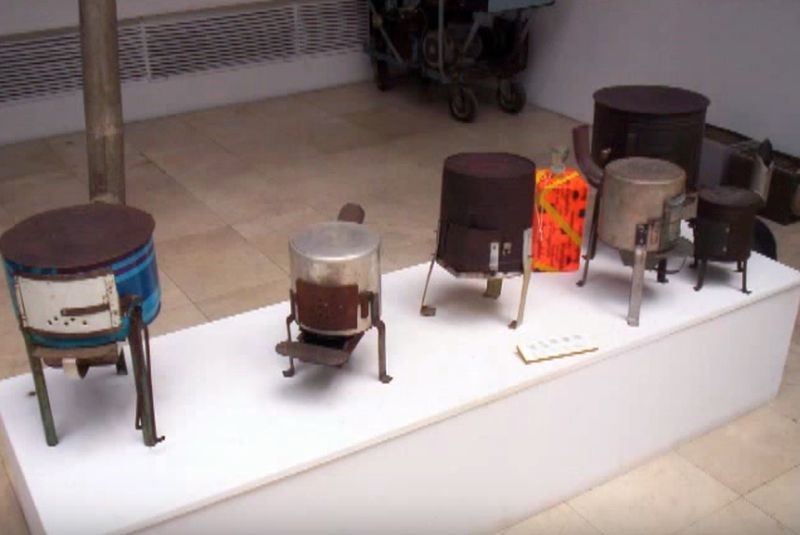
War hand made stoves (the second one on photo is pressure cooker stove) If we had only small made stove we surrounded it with bricks in order to retain heat for more time (in the bricks), and later bricks could be taken in bed.
Today I would not suggest that you make stove from pressure cooker or similar, point is to have stored way somewhere to heat your self with firewood in the most economic way, no matter if you do not need that today because you solve your heating with electricity.
Where did you get fuel for fires?
It was taken care of in layers and depending on the security situation.
For example, if the situation was good, you would go out and chop trees from park or nearest hill with trees. If the situation was bad, then we burned furniture, books, shelves.
By the end of the worst period, people took down all available trees in town, wooden door and window frames from destroyed and abandoned houses, pieces of furniture, wooden floor tiles, and similar.
Over the time we learned value or caloric value of fuel, so, for example, wooden floor tiles were great (especially if the polish coating was good) because it caught fire easily and burned good with lot of energy. Or I used to know that I could make a quick meal out of firing old shoes if they were of particular material if i manage to start fire. (Yes, it smelled awful.)
Finding fuel for fire was an ongoing, time -consuming process, and never-ending.
It was a mess having a whole bunch of people trying, for example, to take down a big tree, then chop it in small pieces, and then to transport it in some way back to home.
Some of use never used an ax before that.
What about winter clothing? Were you just stuck with what you already had? Did people make their own during this time?
Yes, more or less we were stuck with what we had, and people do not actually realize how much their clothing is based on fact that they are living in a system that takes care of them.
Again, comfort and how does it look became not important (if did not attract unnecessary attention).
People again “rearranged“ their stuff in order to make it useful so you could see all kind of weird things like ponchos or vests made from blankets ( simple hole in blanket, and pieces of rope) or nylon in boots, or paper inside jackets and pants, raincoats made from pieces of nylons or pieces of military tents (taken from abandoned barracks), but most important thing was dressing in layers of all kind of different clothes.
If you had, for example, an old granny in your family who knew to knit (it was kinda tradition here) and if she had enough material it was very precious because you had source for gloves, socks and similar, and also good source for trade.
We were missing heavy duty items in our clothes, we were ordinary city folks who suddenly were thrown in life with a lot of heavy jobs, so clothes (just like everything else) deteriorated much faster than in normal times.
Did people die or suffer cold-related injuries like frostbite?
Yes, we were forced to look for resources no matter what kind of weather was outside,
Frostbites happened, but also I strongly believe that something a bit different was much bigger problem.
Usually people in prepping comunnity (and elsewhere too) when it comes to cold weather danger forget it. It is called sometimes urban hypothermia.
In normal times you may see that condition in elderly people who are living alone in poor condition (They do not move too much and their circulation is poor.)
It is a condition when people are exposed to prolonged cold environments inadequately heated houses, homes in poor condition (wet, damp for example), and when you connect that with possible bad quality food, a lot of stress, you may find yourself in a bad state pretty fast.
Older people were especially vulnerable to that (particularly if they already had some medical issues). Their immunity systems went down fast and then they got sick.
It was like we all found ourselves living in 3rd world country conditions.
Frostbites happened fast, and you could reverse the process if you got help fast. Living in a poor (cold more or less) overall condition was something that we could not help a lot.
Do you have any personal stories from that winter that you could share with us?
Fire is very important to keep yourself warm when SHTF. No matter how well you are prepared with some other way of heating and fuel (gas, diesel…) sooner or later, in prolonged SHTF during the winter you will end up with heating yourself with wood fire.
It makes a lot of sense to have that means ready today somewhere, no matter how modern your home is.
One thing is for sure, when SHTF all things look twice as hard when you are cold, and usually they are.
In some of the hardest situations when temperatures were around -20 and I had to get done some hard tasks, I used to drink alcohol together with small amounts of sugar because an urban myth was that helps in low temperatures. That was wrong, of course, and luckily I survived, but the point is to understand what kind of food helps you in cold temperatures and what of that you may have stored.,
For example I would give a lot in that times to have a simple hot chicken soup that maybe costs today around 1 euro and it takes 3 minutes to make it ready.
I learned in that times that having a small fire in the middle of the night in cold weather not only can keep you warm but also can give you psychological strength to move on, to give you reason to live, or let’s say to make you see the light in what look like desperate situation.
Is there anything else you want to tell us about what must have been a terrible winter? (Did I miss anything important?)
Connected to winter, cold, and fire, people tend to forget that they need to have means to start fire, A LOT of that.
Simply over the time some everyday things like lighters become rare and pretty expensive to trade, and fire was not something that you kept going all the time (resources again), and quality of wood was often horrible so often we had lot of problems to start a fire.
Anything that helps with starting a fire makes sense to have in great quantities, things like a lot of lighters, kindling, candles, fuel cubes.
Do you have a plan to stay warm during a long-term scenario?
Reading this, I realized my plan is pretty good for the short term, but definitely wouldn’t be sufficient here in my rental home for a long-term situation. I’ll be adding a few supplies to my list thanks to Selco’s advice.
I noted many of the recommendations he had in this interview:
- Duct tape
- Winter gear that is sturdier than what you need right now
- The ability to knit/crochet sturdy items
- A way to heat with wood, regardless of your current situation (This little stove has fantastic reviews but you will have to have a way to vent and a way to protect your walls and floors so they don’t catch on fire. Stock up on those things as well)
- A way to vent a wood heater (get the right type of stove pipe for your heater, think ahead where you will vent it, and get the proper supplies to seal around the opening and pipe so the heat doesn’t escape.)
- A way to block off part of the house and just keep one area warm
- The ability to use an ax
- Lighters
- Matches
- Firestarters
- Fuel Cubes
- Kindling
- Candles
- Cans of spray foam insulation
Did this give you some food for thought? Will you be adding some supplies or making any changes to your winter plan based on Selco’s interview?
More information about Selco
Selco survived the Balkan war of the 90s in a city under siege, without electricity, running water, or food distribution.
In his online works, he gives an inside view of the reality of survival under the harshest conditions. He reviews what works and what doesn’t, tells you the hard lessons he learned, and shares how he prepares today.
He never stopped learning about survival and preparedness since the war. Regardless what happens, chances are you will never experience extreme situations like Selco did. But you have the chance to learn from him and how he faced death for months.
Real survival is not romantic or idealistic. It is brutal, hard and unfair. Let Selco take you into that world.
Read more of Selco’s articles here: SHTF School
Some have seen this problem coming for a long time and changed their entire way of life by going off-grid. They have found alternative sources such as solar, wind and diesel to power their homes and machinery. A majority of us, who have not gone off-grid, are making a concerted effort to avoid dependence on this ailing infrastructure and preparing for life without it.
Books can be your best pre-collapse investment.
Old Time Wisdom ( Timeless Bits of Wisdom on How to Grow Everything Organically, from the Good Old Days When Everyone Did you can prepare yourself for war by moving to the countryside and building a farm, but you must take guns with you, as the hordes of starving will be roaming. Also, even though the elite will have their safe havens and specialist shelters, they must be just as careful during the war as the ordinary civilians, because their shelters can still be compromised.”)
The Lost Ways (Learn the long forgotten secrets that helped our forefathers survive famines,wars,economic crisis and anything else life threw at them)
LOST WAYS 2 ( Word of the day: Prepare! And do it the old fashion way, like our fore-fathers did it and succeed long before us, because what lies ahead of us will require all the help we can get. Watch this video and learn the 3 skills that ensured our ancestors survival in hard times of famine and war.)

